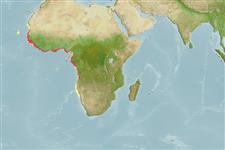Environment: milieu / climate zone / djupintervall / distribution range
Ekologi
marina bottenlevande; djupintervall 15 - 300 m (Ref. 55). Subtropical; 21°N - 25°S, 24°W - 15°E (Ref. 55)
Eastern Atlantic: Mauritania to Namibia, including Cape Verde (Ref. 10795). Records of this species from the western Indian Ocean are probably based on misidentifications.
Size / Vikt / Age
Könsmognad: Lm ? range ? - ? cm
Max length : 75.0 cm TL hane/ej könsbestämd; (Ref. 55); common length : 60.0 cm TL hane/ej könsbestämd; (Ref. 55)
Short description
Bestämningsnycklar | Morfologi | Morfometri
Taggstrålar i ryggfenan (totalt) : 10; Mjukstrålar i ryggfenan (totalt) : 10; Taggstrålar i analfenan: 3; Mjukstrålar i analfenan: 8. Interorbital space broad and convex. Scale rows on back parallel to lateral line. Back and sides dark brown, lighter on belly and underside of head.
Body shape (shape guide): fusiform / normal; Cross section: oval.
Adults inhabit coralline and rocky bottoms (Ref. 2683). Feed on small fishes, squids and crustaceans. Flesh of good quality.
Life cycle and mating behavior
Könsmognad | Reproduktion | Lek | Ägg | Fecundity | Larver
Allen, G.R., 1985. FAO Species Catalogue. Vol. 6. Snappers of the world. An annotated and illustrated catalogue of lutjanid species known to date. FAO Fish. Synop. 125(6):208 p. Rome: FAO. (Ref. 55)
IUCN Red List Status (Ref. 130435: Version 2025-1)
Threat to humans
Harmless
Human uses
Fiskeri: mindre kommeriell
Verktyg
Special reports
Download XML
Internet-källor
Estimates based on models
Preferred temperature (Ref.
123201): 15.4 - 20.5, mean 16.8 °C (based on 34 cells).
Phylogenetic diversity index (Ref.
82804): PD
50 = 0.7500 [Uniqueness, from 0.5 = low to 2.0 = high].
Bayesian length-weight: a=0.00912 (0.00496 - 0.01677), b=3.04 (2.87 - 3.21), in cm total length, based on LWR estimates for this species & (Sub)family-body (Ref.
93245).
Trofisk nivå (Ref.
69278): 4.0 ±0.58 se; based on food items.
Resiliens (Ref.
120179): Låg, lägsta populationsfördubblingstid 4,5-14 år (Preliminary K or Fecundity.).
Fishing Vulnerability (Ref.
59153): Moderate to high vulnerability (50 of 100).
🛈
Nutrients (Ref.
124155): Calcium = 49.7 [18.6, 98.1] mg/100g; Iron = 0.876 [0.462, 1.549] mg/100g; Protein = 19 [17, 21] %; Omega3 = 0.386 [0.238, 0.649] g/100g; Selenium = 37.6 [20.7, 70.4] μg/100g; VitaminA = 10.8 [3.5, 38.7] μg/100g; Zinc = 0.565 [0.389, 0.836] mg/100g (wet weight);
